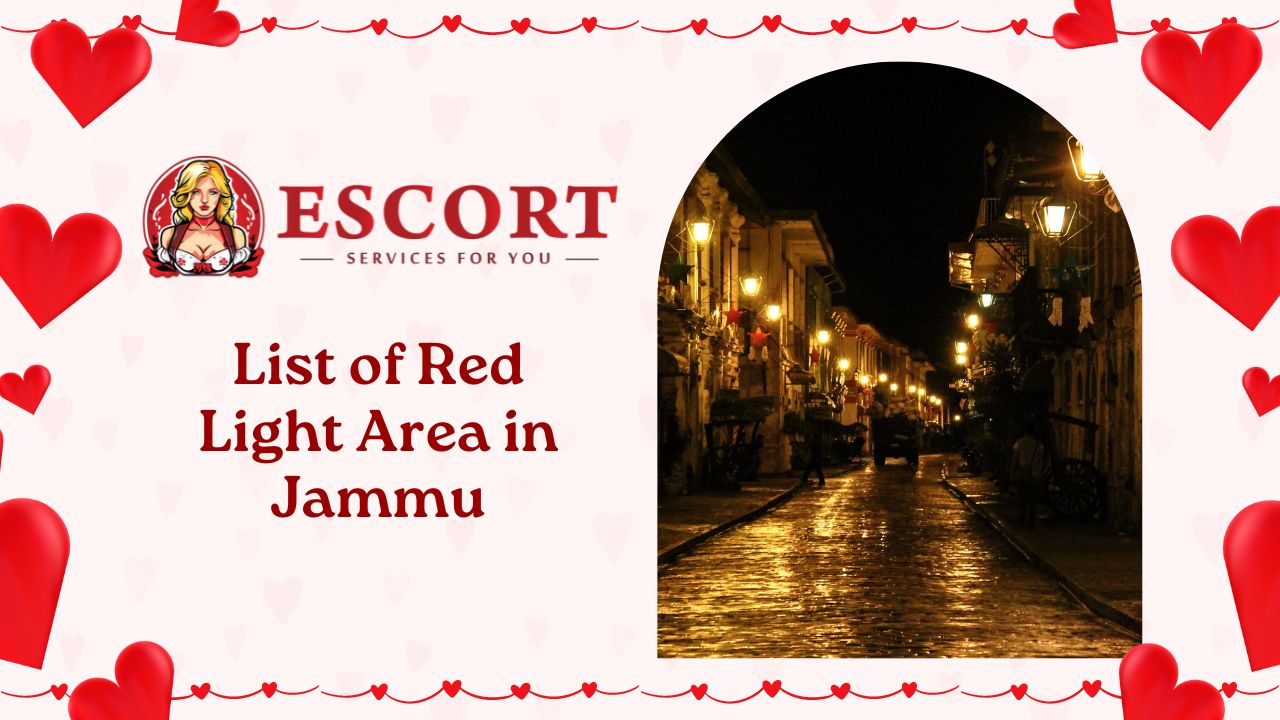Welcome to our exploration of the lesser-known side of Jammu – the Red Light Areas. Delve into the history, current state, controversies, and initiatives surrounding these areas as we shed light on a topic often hidden in the shadows. Let’s embark on a journey through Nanak Nagar, Bhagwati Nagar, New Rehari, Jawahar Nagar, Gandhi Nagar, Trikuta Nagar Extension, Shastri Nagar, Channi Himmat Colony, Karan Market and New Plots to uncover the realities and complexities of these neighborhoods.
What is a Red Light Area?
Red Light Areas are districts in cities where commercial sex work is prevalent. These areas are characterized by a concentration of brothels, bars, and nightclubs catering to clients seeking sexual services for payment. The term “red light” originates from the red lights traditionally used to signal the presence of brothels.
In Red Light Areas, women typically work as prostitutes, engaging in sexual activities with customers in exchange for money. These women often face various challenges such as exploitation, violence, and social stigma due to their profession.
Red Light Areas can vary in size and structure, with some being organized and regulated while others operate informally. They remain controversial and complex spaces that raise ethical, legal, and social concerns within communities.
Despite the controversies surrounding them, Red Light Areas continue to exist globally as part of the underground economy that intersects with issues of poverty, gender inequality, and human rights.
History of Red Light Areas in Jammu
Let’s delve into the historical roots of Red Light Areas in Jammu. These areas have a complex past, dating back to colonial times when they were established to cater to the needs of soldiers and traders. Over the years, these districts evolved into hubs for commercial sex work, shaping the city’s social fabric.
The history of Red Light Areas in Jammu is intertwined with societal norms, economic factors, and cultural influences. Despite facing stigma and legal challenges, these areas have continued to operate as spaces where marginalized women seek livelihoods through sex work.
As urbanization and globalization transformed Jammu, so did its Red Light Areas. From traditional brothels to online solicitation, the landscape has evolved while retaining its core dynamics.
Understanding this history sheds light on the complexities surrounding these areas today. It also underscores the need for holistic approaches towards addressing issues faced by individuals involved in sex work within these communities.
The Current State of Red Light Areas in Jammu
The current state of Red Light Areas in Jammu reflects a complex and evolving landscape. From Nanak Nagar to Trikuta Nagar Extension, these areas continue to exist amidst various societal challenges. Despite efforts by authorities, these locations remain hubs for commercial sex work.
Bhagwati Nagar and Shastri Nagar are among the prominent red light zones that attract both local and transient clientele. The presence of such areas raises questions about the overall safety and well-being of those involved in the industry.
Gandhi Nagar and Channi Himmat Colony also have their share of issues related to this underground economy. While some argue for regulation and empowerment of sex workers, others advocate for stricter enforcement measures.
Karan Market and New Plots serve as reminders of the persistent demand for such services in urban centers like Jammu. As these areas grapple with their existence, discussions on addressing root causes gain momentum within the community.
Nanak Nagar
Nanak Nagar in Jammu is known for its bustling streets and vibrant atmosphere. The area is home to a mix of commercial establishments, residential buildings, and various small businesses. At first glance, Nanak Nagar may seem like any other neighborhood in the city, but there’s more than meets the eye.
Hidden within this seemingly ordinary setting are pockets of clandestine activities that have long been a part of Nanak Nagar’s fabric. Behind closed doors and discreetly tucked away corners lie spaces where taboo transactions take place under the veil of anonymity.
Despite its shadowy reputation, Nanak Nagar also holds stories of resilience and survival amidst adversity. The community here navigates through challenges with a sense of solidarity and strength that binds them together.
As day turns into night, Nanak Nagar transforms into a different world altogether – one that operates on its own set of rules and dynamics. It’s a place where realities clash, dreams are shattered, but hope still flickers in the darkness.
Bhagwati Nagar
Nestled in the bustling city of Jammu, Bhagwati Nagar stands as one of the prominent red light areas in the region. With its narrow lanes and dimly lit alleys, this area tells tales of its own. A place where shadows dance with secrets and whispers linger in the air.
Bhagwati Nagar is home to a complex tapestry of lives – women seeking refuge, clients searching for solace, and authorities grappling with challenges. Amidst the chaos, there exists a sense of resilience that echoes through its streets.
The community here thrives amidst adversity, finding ways to survive against all odds. But behind closed doors lie stories untold and struggles unseen. It’s a delicate balance between survival and hope that defines the essence of Bhagwati Nagar.
As we delve deeper into the fabric of this area, we uncover layers of complexities that paint a vivid portrait of life on the fringes. In Bhagwati Nagar, every corner holds a story waiting to be heard and understood – shedding light on realities often overlooked by society at large.
New Rehari
Nestled in the heart of Jammu, New Rehari is known as one of the prominent red light areas in the city. With a history shrouded in mystery and controversy, this area has been a subject of much discussion among locals and authorities alike.
Despite its notoriety, New Rehari continues to operate discreetly, attracting individuals from various walks of life seeking services that are offered within its confines. The streets come alive at night with colorful lights and bustling activities, creating an atmosphere quite unlike any other part of the city.
While some may view it as a place teeming with illicit activities, others see it as a complex ecosystem where livelihoods are sustained through unconventional means. The dynamics at play here are multifaceted and often elicit mixed reactions from those outside looking in.
New Rehari stands as a stark reminder of societal issues that persist despite efforts to address them effectively. As debates rage on about its presence and impact on the community, one thing remains certain – this area will continue to be a focal point for discussions surrounding marginalized groups and their rights.
Jawahar Nagar
Nestled in the heart of Jammu lies Jawahar Nagar, a vibrant area known for its bustling streets and colorful markets. Here, the scent of spices mingles with the sound of vendors calling out their wares, creating a sensory experience like no other.
Jawahar Nagar is not just a commercial hub; it’s also home to a diverse community that adds to the area’s rich tapestry of culture and traditions. From traditional Kashmiri handicrafts to modern boutiques, you can find an array of shopping options here.
As day turns into night, Jawahar Nagar transforms into a lively nightlife hotspot with restaurants serving up mouth-watering local cuisine and cozy cafes where you can unwind after a long day exploring the city.
Whether you’re looking to shop ’til you drop or simply soak in the local atmosphere, Jawahar Nagar offers something for everyone. So next time you’re in Jammu, make sure to pay this dynamic neighborhood a visit!
Gandhi Nagar
Nestled in the heart of Jammu, Gandhi Nagar is known for its bustling streets and vibrant atmosphere. As one of the prominent red light areas in the city, it has a complex history that intertwines with social issues and urban development.
Despite facing controversies and challenges, Gandhi Nagar remains a hub for various activities beyond its reputation. From local markets to eateries serving delicious street food, this area exudes a unique charm that attracts visitors from all walks of life.
The juxtaposition of daily life alongside the presence of brothels creates a stark contrast that captures the essence of resilience and struggle within the community. While some may see it as a place shrouded in darkness, others recognize it as a microcosm of life’s complexities.
Gandhi Nagar stands as a reminder of the need for compassion and understanding towards those affected by circumstances beyond their control. It serves as a poignant symbol of both hardship and hope in an ever-evolving cityscape like Jammu.
Trikuta Nagar Extension
Tucked away in the bustling city of Jammu lies Trikuta Nagar Extension, a neighborhood that holds more than meets the eye. Known for its vibrant streets and diverse community, this area also harbors a lesser-known side – as one of the red light districts in the city.
Amidst the everyday hustle and bustle, hidden stories unfold behind closed doors. Women from different walks of life find themselves working in this unconventional industry, navigating through challenges while striving to make ends meet.
Despite its controversial nature, Trikuta Nagar Extension is not just defined by its red light activities. The area boasts a mix of businesses, residential spaces, and local markets where life goes on amidst the shadows.
As discussions surrounding these areas continue to evolve, it’s essential to shed light on the complexities that exist within them. While controversies may surround these neighborhoods, they remain an integral part of Jammu’s urban fabric.
Shastri Nagar
Located in the heart of Jammu, Shastri Nagar is known for its vibrant atmosphere and bustling streets. The area is home to a mix of residential buildings, commercial establishments, and local markets that cater to the needs of both residents and visitors alike.
Shastri Nagar has a unique charm with its diverse range of shops offering everything from traditional clothing to modern electronic gadgets. Visitors can also enjoy a variety of street food options, adding to the lively vibe of the neighborhood.
The community in Shastri Nagar is tight-knit, with locals often coming together for cultural events and festivals. This sense of camaraderie creates a welcoming environment for all who visit this dynamic area.
Despite being one of the older neighborhoods in Jammu, Shastri Nagar continues to evolve with time, blending tradition with modernity seamlessly. Whether you’re looking to shop, eat delicious food or simply soak in the local culture, Shastri Nagar offers something for everyone.
Channi Himmat Colony
Nestled in the heart of Jammu, Channi Himmat Colony stands out as a vibrant and bustling neighborhood with its own share of complexities. Amidst the residential streets and local shops, this area is known for housing a red light district that has been a subject of controversy and concern.
Despite efforts to address the issues surrounding this part of Channi Himmat Colony, challenges persist in ensuring the safety and well-being of those involved. The presence of red light activities raises questions about societal norms and community impact, prompting discussions on measures needed to address these complex issues effectively.
As conversations continue about the future of red-light areas like Channi Himmat Colony, it remains essential to consider alternative opportunities for women working in such environments. By exploring sustainable solutions and support systems, we can strive towards creating safer spaces for all members of our community.
Karan Market
Tucked away in the bustling streets of Jammu lies Karan Market, a vibrant hub that tells its own story amidst the chaos. Walking through its narrow lanes, you can feel the pulse of this unique marketplace beating with energy and diversity.
From colorful fabrics to aromatic spices, Karan Market is a treasure trove for those seeking a taste of local culture and craftsmanship. The sights and sounds here create a sensory symphony that leaves a lasting impression on visitors.
Amidst the hustle and bustle, one can find hidden gems waiting to be discovered – quaint shops selling traditional handicrafts, street food vendors dishing out local delicacies, and friendly faces ready to share stories of their beloved market.
Karan Market may not be as renowned as other attractions in Jammu, but it holds its own charm that draws both locals and tourists alike. It’s more than just a marketplace; it’s a slice of life in this vibrant city.
New Plots
Nestled in the heart of Jammu, New Plots stands as a discreet red light area, known for its bustling nightlife and vibrant energy. The area pulsates with life as visitors roam the streets filled with neon lights and intriguing establishments.
New Plots is a melting pot of cultures and backgrounds, where individuals from all walks of life come together in pursuit of various desires. From cozy bars to lively clubs, this area offers a range of entertainment options for those seeking an escape from their daily routine.
The colorful facades hide stories of resilience and strength as women navigate through the complexities of their profession. Behind closed doors, they strive to make ends meet while maintaining a sense of dignity amidst societal stigmas.
Despite its controversial nature, New Plots serves as a symbol of survival for many marginalized communities who rely on it for livelihood. As dusk falls, the streets come alive with whispers of untold tales waiting to be discovered.
Controversies and Issues Surrounding Red Light Areas in Jammu
Controversies and issues surrounding red light areas in Jammu have been a topic of heated discussions for years. The presence of these areas often sparks debates on morality, ethics, and social implications within the community. Critics argue that such zones promote exploitation and human trafficking, leading to a cycle of abuse and suffering.
On the other hand, proponents suggest that regulating these spaces can provide some level of safety for sex workers while acknowledging the complexities involved. However, concerns over public health risks, crime rates, and moral decay persist among residents living near these red light districts.
Despite efforts from authorities to address these challenges through various initiatives and interventions, finding sustainable solutions remains a significant challenge. Balancing the rights and well-being of individuals involved with the broader impact on society continues to be a delicate issue that requires careful consideration and thoughtful actions moving forward.
Impact on Local Community and Society
The presence of red light areas in Jammu has a significant impact on the local community and society. It can lead to an increase in crime rates, including human trafficking, drug abuse, and violence. The proximity of such areas to residential neighborhoods can create safety concerns for residents, especially women and children.
Moreover, the stigmatization associated with these areas can have lasting effects on both the workers and their families. It often perpetuates social exclusion and discrimination against those involved in the sex trade. This further deepens societal divides and hinders efforts towards building a more inclusive community.
Additionally, the presence of red light areas can also strain public resources as law enforcement agencies are required to allocate additional manpower and funds to monitor these areas effectively. This diversion of resources could potentially affect other critical aspects of community safety and well-being.
The impact of red light areas on the local community goes beyond just physical boundaries; it extends into social fabrics that require thoughtful consideration and comprehensive solutions for sustainable change.
Government and NGO Initiatives to Address the Issue
Government and NGOs in Jammu have been actively working to address the issues surrounding red light areas. Various initiatives have been implemented to provide support and rehabilitation for women involved in such activities. These organizations focus on empowering these women by offering skill development training, healthcare services, and counseling.
The government has also taken steps to combat human trafficking and illegal activities within these areas. Through awareness campaigns, law enforcement efforts, and collaboration with local authorities, they aim to eradicate exploitation and improve the overall well-being of individuals affected.
NGOs play a crucial role in providing a safe space for women seeking refuge from the harsh realities of red light areas. They offer shelter homes, legal assistance, educational opportunities, and vocational training to help them break free from the cycle of exploitation.
By working hand in hand with government agencies, NGOs continue their tireless efforts to create a more inclusive and supportive environment for those impacted by red light areas in Jammu.
Alternatives for Women Working in Red Light Areas
For women working in red light areas in Jammu, transitioning to a different livelihood can be daunting yet empowering. Various organizations offer vocational training programs to equip these women with skills for alternative employment opportunities. From tailoring and handicrafts to beauty services and hospitality, these programs aim to provide sustainable income options outside the sex trade.
Moreover, initiatives focusing on financial literacy and entrepreneurship empower these women to start their own small businesses. By fostering independence and self-reliance, these initiatives help break the cycle of exploitation.
Counseling and support services are also crucial in helping women navigate this transition period. Mental health professionals play a significant role in addressing trauma and building resilience as they embark on a new chapter in their lives.
Offering alternatives for women working in red light areas is essential not only for their economic well-being but also for their emotional healing and social reintegration.
Conclusion
The issue of red light areas in Jammu is complex and multi-faceted, impacting not only the women working in these areas but also the local community and society at large. While efforts are being made by the government and NGOs to address this issue through various initiatives, more work needs to be done to provide viable alternatives for women working in red light areas.
It is crucial for us as a society to approach this issue with empathy, understanding, and a commitment to finding sustainable solutions that empower these women and protect their rights. By fostering a more inclusive and supportive environment, we can strive towards creating a safer and more dignified future for all individuals involved in or affected by red light areas in Jammu.




